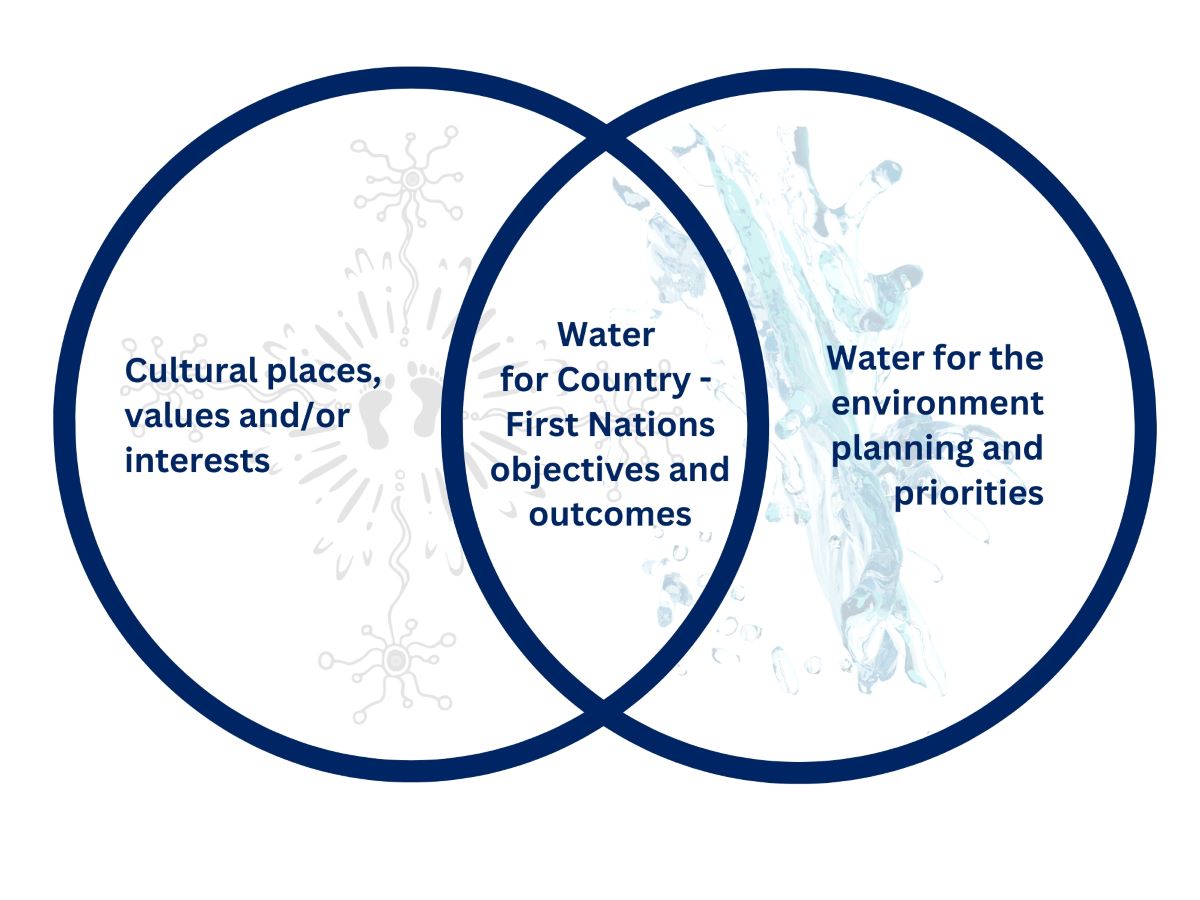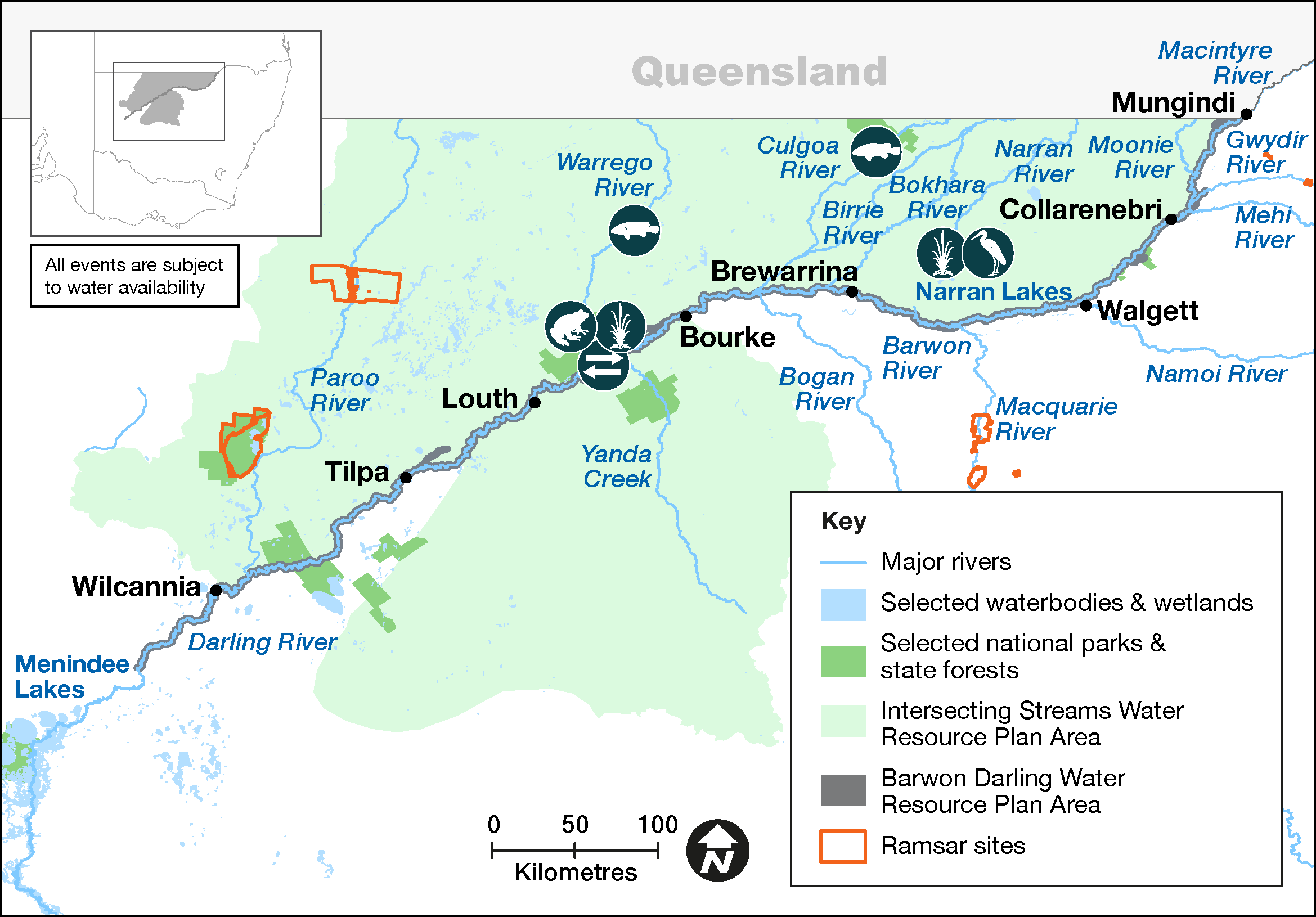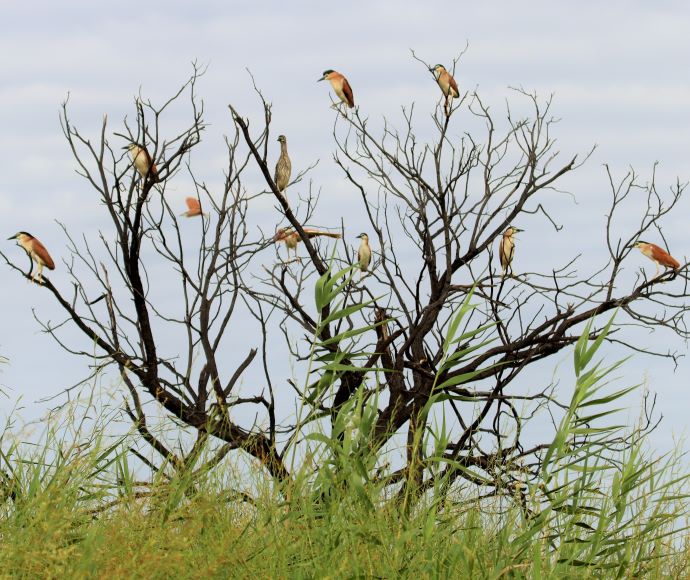Water that is allocated and managed specifically to improve the health of rivers, wetlands and floodplains is known as water for the environment.
NSW environmental water management teams work with local communities, Aboriginal representatives, partner agencies, and other stakeholders to develop detailed annual plans for the use of water for the environment in each catchment, including how its use is prioritised.
The catchment
The Intersecting Streams cover an area of approximately 120,431 km2. This area comprises the NSW sections of 4 key river systems: the Paroo, Warrego, Culgoa–Birrie–Bokhara–Narran connected system and Moonie River, which originate in Queensland and terminate in New South Wales.
There are 3 listed Ramsar sites and areas indicated in the Directory of Important Wetlands located in the Paroo, Warrego and Narran water sources and an Important Bird Area identified by BirdLife Australia.
The Intersecting Streams catchment is Country to the Barkindji, Budjiti, Euahlayi, Guwamu/Kooma, Gomeroi/Kamilaroi, Ngiyampaa, Kunja, Murrawarri and Ngemba Aboriginal people.
Water for rivers and wetlands
The Intersecting Streams rely on rainfall in southern Queensland and connection across the NSW–Queensland border to generate flows that support rivers and wetlands in this area.
The region saw well above average rainfall from late 2021 to late 2022. This rainfall created periods of high flow across the Intersecting Streams, with notable flows up to:
- 11,012 megalitres (ML) per day in the Paroo at Willara gauge
- 11,373 ML per day in the Culgoa at Collerina gauge
- 4,194 ML per day in the Narran at Narran Park gauge.
This rainfall generated significant flow to Narran Lakes and the Paroo and Bulloo rivers wetlands. While there were significant flows in the Warrego, only a small volume was directed to the Western Floodplain in early 2023 at Toorale.
With wet conditions in the northern basin reducing, critical environmental demands may come back into focus, particularly in relation to connectivity. In 2023–24, the focus of water managers will shift to recovery and maintaining current system conditions where possible.
Aboriginal water management priorities

Environmental water managers have been working to support Aboriginal people’s priorities in water management.
Water for Country is environmental water use planned by the Department of Climate Change, Energy, the Environment and Water and Aboriginal people to achieve shared benefits for the environment and cultural places, values and/or interests.
We will partner with the Toorale Aboriginal Joint Management Committee to better manage flows to the Western Floodplain to address priorities and support the development of a cultural water management plan.
Weather and water forecast
As at early June the El Niño–Southern Oscillation (ENSO1) outlook is neutral, with a 50% chance that an El Niño may develop in late 2023. Rainfall was above average for July to November in central Qld and north-western NSW including much of the Intersecting Streams. The wet conditions began to subside in December 2022 and have continued to become dryer in early 2023.
Natural inflows are likely to stay low or decrease further in the Intersecting Streams in the 2023–24 water year, reducing opportunities for water managers to use environmental water licenses to protect flows in the Barwon–Darling Barwaan–Culliwatta–Baaka catchment. There is potential for widespread very low flow and cease to flow conditions to return in the catchment.
Water managers have prepared annual watering plans that consider a range of weather and water availability scenarios. This is known as resource availability scenario planning. On balance, the outlook is rated as ‘dry to moderate’.
1. ENSO: The interaction between the sea surface and atmosphere over the Pacific Ocean which results in dryer (El Nino) or wetter (La Nina) conditions.
Resource availability scenario
Current forecast: Dry to moderate
| Forecast | Main aim | Other aims |
|---|---|---|
| Very dry | Protect | Avoid critical loss Maintain key refuges Avoid catastrophic events |
| Dry | Maintain | Maintain river functioning Maintain key functions of high priority wetlands |
| Moderate | Recover | Improve ecological health and resilience Improve opportunities for plants and animals to breed, move and thrive |
| Wet to very wet | Enhance | Restore key floodplain and wetland linkages Enhance opportunities for plants and animals to breed, move and thrive |
Key planned actions for 2023–24
Waterbirds
In 2023–24, water is likely to be retained in Narran Lake due to an extended period of inflows which began in late 2021 and were followed by an event-based mechanism release in early 2023. A priority is to ensure an adequate vegetation condition and water level should further inflows trigger another colonial waterbird breeding event in spring 2023.
Native fish
A key priority for water managers is to support native fish populations and provide opportunities for them to breed and disperse into secure habitats.
Vegetation
The water that reached the Narran Lakes in late 2021 and early 2022 is expected to have further improved vegetation condition in the lakes system. Water managers will prioritise opportunities that arise in 2023–24 to increase the duration of inundation of water-dependent vegetation.
In the Warrego River in mid-2021, flows inundated vegetation communities on the Toorale Western Floodplain wetland, and they were further inundated in late 2022 and early 2023. Repeated inundation in 2023–24 will increase vigour and diversity of wetland vegetation in this location.
Connectivity
Flows and inter-system connections depend on rainfall occurring throughout the year. Connectivity between the Warrego and Darling Baaka can be influenced at Toorale, with downstream connection being the priority and connection being maintained when environmental water is delivered to the Western Floodplain.
Water for the environment will be delivered at Toorale in line with the priorities set out in the Toorale water management infrastructure operating and maintenance plan.
When there is no identified priority, the Barwon–Darling Barwaan–Culliwatta–Baaka and Intersecting Streams Environmental Water Advisory Group will be consulted. This group is being developed and is expected to be operational within the 2023–24 water year.
Map of proposed annual priority targets in the water resource plan area 2023–24

Map of the Intersecting Streams catchment area showing priority targets for environmental water to be delivered to in 2023-24.
The Department of Climate Change, Energy, the Environment and Water is supporting the health and resilience of rivers and wetlands by delivering water for the environment where and when it is needed. We use the best available science, management expertise and experience to manage water across the landscape. This statement of annual priorities identifies the waterways and wetlands that are likely to receive water.
Our decision-making process considers:
- expected availability of water in the coming year
- conditions of the previous year
- current health of the plants and animals in these ecosystems.
Water for the environment delivers benefits for communities, rivers, wetlands and wildlife across New South Wales.
Healthy, connected rivers and floodplains are a focus for tourism, fishing, recreation and relaxation. Rivers carry water to our homes, schools, farms and businesses, and along the way, support countless species including native fish, waterbirds, frogs, plants and more.
Rivers and wetlands have great cultural and spiritual significance for Aboriginal people.
Water for the environment is a critical tool to maintain and enhance the rivers, wetlands and wildlife we all love.
Working with communities
Local communities are at the heart of everything we do.
We involve the broader community by holding site tours and forums, and online and in-person events.
In catchments that have community-based environmental water advisory groups, NSW water management teams consult with them regularly.
Environmental water advisory group members include local landholders, recreational fishers, Aboriginal people and local government representatives. Their advice helps to inform the decisions made by our local environmental water management teams.
The Intersecting Streams catchment doesn’t currently have an environmental water advisory group, but the Department of Climate Change, Energy, the Environment and Water are in the process of developing one.
The Department of Climate Change, Energy, the Environment and Water works with partner agencies to manage environmental water in the catchment.
Water licenced to the Commonwealth
Moonie
| Source | Maximum volume available (megalitres) | Volume expected 1 July under current conditions (megalitres) |
|---|---|---|
| Queensland unsupplemented | 5,671 | Event dependent |
Condamin-Balonne
| Source | Maximum volume available (megalitres) | Volume expected 1 July under current conditions (megalitres) |
|---|---|---|
| Nebine unsupplemented | 5,920 | Event dependent |
| Lower Balonne unsupplemented | 68,317 | Event dependent |
| Condamine-Balonne unsupplemented | 1,062 | Event dependent |
| Condamine-Balonne overland flow | 96,741 | Event dependent |
| Upper Condamine unsupplemented | 841 | Event dependent |
| Upper Condamine groundwater | 40,221 | n/a |
| St George (medium) | 45 | 0 |
Warrego
| Source | Maximum volume available (megalitres) | Volume expected 1 July under current conditions (megalitres) |
|---|---|---|
| Queensland unsupplemented | 39,445 | Event dependent |
| New South Wales unregulated | 17,826 | Event dependent |
Notes: This is an indicative summary of expected volumes to be available. For further detail and information on available volumes you can contact the region via the Department of Climate Change, Energy, the Environment and Water on 1300 361 967.
1 gigalitre = 1000 megalitres; 2.5 megalitre = 1 Olympic swimming pool.
Water for the environment has been delivering outcomes for rivers, wetlands and wildlife for 30 years.
We deliver flows that:
- trigger native fish to breed and move
- support waterbirds to nest and feed
- connect rivers and floodplains
- water forests and floodplains
- allow plants to grow, flower and set seed
- create refuge during droughts
- enhance outcomes during wetter times
- release vital nutrients from the floodplain floor that underpin the aquatic food web.
It’s habitat restoration on a landscape scale.

Nankeen night herons at South Arm, Narran
More information on planned and past watering events
- Annual environmental water priorities in the Intersecting Streams catchment 2022–23
- Intersecting Streams – Water for the Environment: Annual Priorities 2021–22
- Intersecting Streams: Annual environmental watering priorities 2020–21
- Intersecting Streams: Annual environmental watering priorities 2019–20
- Water for environment outcomes 2022–23
- Water for environment outcomes 2021–22
- Use of water for the environment in NSW: Outcomes 2020–21
- Use of water for the environment in NSW: Outcomes 2019–20
- Use of water for the environment in NSW: Outcomes 2018–19